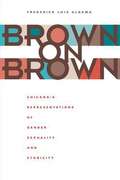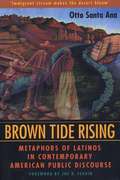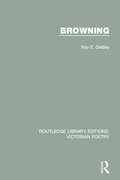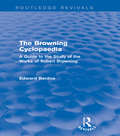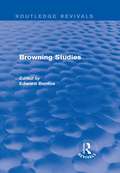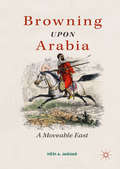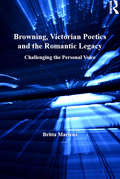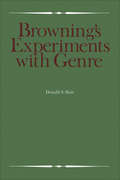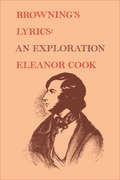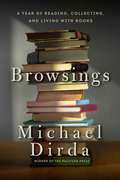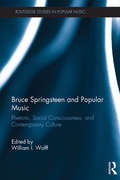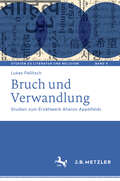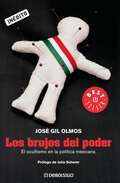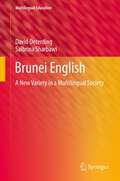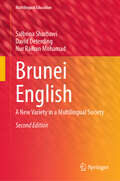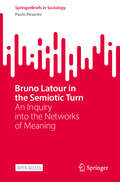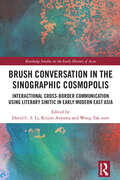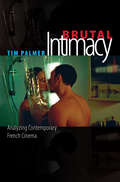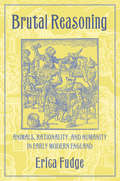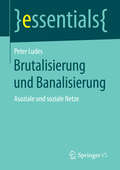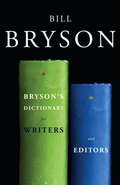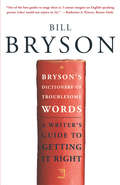- Table View
- List View
Brown on Brown: Chicano/a Representations of Gender, Sexuality, and Ethnicity
by Aldama Frederick LuisIn this book, Frederick Luis Aldama follows an entirely different approach. He investigates the ways in which race and gay/lesbian sexuality intersect and operate in Chicano/a literature and film while taking into full account their imaginative nature and therefore the specific kind of work invested in them. Also, Aldama frames his analyses within today's larger (globalized) context of postcolonial literary and filmic canons that seek to normalize heterosexual identity and experience. Throughout the book, Aldama applies his innovative approach to throw new light on the work of authors Arturo Islas, Richard Rodriguez, John Rechy, Ana Castillo, and Sheila Ortiz Taylor, as well as that of film director Edward James Olmos. In doing so, Aldama aims to integrate and deepen Chicano literary and filmic studies within a comparative perspective. Aldama's unusual juxtapositions of narrative materials and cultural personae, and his premise that literature and film produce fictional examples of a social and historical reality concerned with ethnic and sexual issues largely unresolved, make this book relevant to a wide range of readers.
Brown Tide Rising: Metaphors of Latinos in Contemporary American Public Discourse
by Santa Ana OttoHe convincingly demonstrates that three anti-Latino referenda passed in California because of such imagery, particularly the infamous anti-immigrant measure, Proposition 187. Santa Ana illustrates how Proposition 209 organizers broadcast compelling new metaphors about racism to persuade an electorate that had previously supported affirmative action to ban it. He also shows how Proposition 227 supporters used antiquated metaphors for learning, school, and language to blame Latino children's speech—rather than gross structural inequity—for their schools' failure to educate them. Santa Ana concludes by calling for the creation of insurgent metaphors to contest oppressive U.S. public discourse about minority communities.
Browning (Routledge Library Editions: Victorian Poetry #2)
by Roy E. GridleyFirst published in 1972. Browning was a keen observer and dramatic recorder of nineteenth-century European culture; his poetry reflects a wide range of intellectual, religious and artistic issues of his day. Roy E. Gridley shows here that during the six decades of Browning’s active writing career (1832-89), his poetry is a record and an interpretation of the changing modes of thought, feeling and expression of nineteenth-century life. Browning was a ‘romantic’ who, by virtue of his realistic and often revolutionary poetry, became a ‘modern’, and had considerable influence on writers such as Yeats, Eliot and Pound. While surveying the whole of Browning’s life and work, Gridley focuses closely on the more famous poems, examining them as documents that give the general reader a deeper appreciation of the richness and diversity of life in Victorian Europe.
The Browning Cyclopaedia: A Guide to the Study of the Works of Robert Browning (Routledge Revivals)
by Edward BerdoeRobert Browning, the great Victorian poet, is often claimed to be hard to understand, largely on account of the obscurity of his language, the complexity of his thought, and his poetic style. The Browning Cyclopaedia, first published in 1891, presents an exposition of the prominent ideas of each poem, as well as its tone, its sources – historical, legendary or fanciful – and a glossary of every difficult word or allusion which might obscure the poem’s meaning. This volume remains indispensable for students of Robert Browning, as well as those interested in the general aesthetic climate of Victorian poetry.
Browning Studies: Being Select Papers by Members of the Browning Society (Routledge Revivals)
by Edward BerdoeThis title, first published in 1909, presents a selection of the most important essays by members of the renowned Browning Society, which existed to promulgate the works of and appreciation for perhaps the greatest English poet of the Victorian Age. Browning’s poetry deals with themes that are of perennial importance: the nature of the human person, human love, and the source of the love, God. Browning Studies will appeal to Browning enthusiasts and the message his writing communicates: "A profound, passionate, living, triumphant faith in Christ, and in the immortality and ultimate redemption of every human soul in and through Christ."
Browning Upon Arabia: A Moveable East
by Hédi A. JaouadBrowning Upon Arabia charts Robert Browning’s early and enduring engagement with the East, particularly the Arab East. This book highlights the complexities of Browning’s poetry, revealing Browning’s resistance to triumphalist and imperialist forms of Orientalism generated by many nineteenth-century British and European literary and scholarly portrayals of the East. Hédi A. Jaouad argues that Browning extensively researched the literature, history, philosophy, and culture of the East to produce poetry that is sensitive to its Eastern resources and devoted to confirming the interrelation of Northern and Eastern knowledge in pursuit of a new form of transcendental humanism.
Browning, Victorian Poetics and the Romantic Legacy: Challenging the Personal Voice (Ashgate Popular And Folk Music Ser.)
by Britta MartensTaking an original approach to Robert Browning's poetics, Britta Martens focuses on a corpus of relatively neglected poems in Browning's own voice in which he reflects on his poetry, his self-conceptualization and his place in the poetic tradition. She analyzes his work in relation to Romanticism, Victorian reactions to the Romantic legacy, and wider nineteenth-century changes in poetic taste, to argue that in these poems, as in his more frequently studied dramatic monologues, Browning deploys varied dramatic methods of self-representation, often critically and ironically exposing the biases and limitations of the seemingly authoritative speaker 'Browning'. The poems thus become devices for Browning's detached evaluation of his own and of others' poetics, an evaluation never fully explicit but presented with elusive economy for the astute reader to interpret. The confrontation between the personal authorial voice and the dramatic voice in these poems provides revealing insights into the poet's highly self-conscious, conflicted and sustained engagement with the Romantic tradition and the diversely challenging reader expectations that he faces in a post-Romantic age. As the Victorian most rigorous in his rejection of Romantic self-expression, Browning is a key transitional figure between the sharply antagonistic periods of Romanticism and Modernism. He is also, as Martens persuasively demonstrates, a poet of complex contradictions and an illuminating case study for addressing the perennial issues of voice, authorial authority and self-reference.
Browning's Experiments with Genre
by Donald HairOne of the chief characteristics of nineteenth-century poetics was a tendency to test the conventions and techniques of literary genres by shifting, modifying, and combining various styles and forms. Browning fully exploited these changes, because his interests and purposes as a poet seemed to demand more of the lyric, the dramatic, and the narrative than these kinds had traditionally been able to perform. His fascination was with the development of the individual soul and he was determined to evoke in his readers his own insights into the complexity of human concerns; thus he became a constant experimenter with genre. Browning never felt that any experiment, however unsatisfactory the result, was wasted effort; each direction tried made him better prepared to attempt another. This book explores the kinds and modes with which he worked and describes the nature of the experiments he made, concentrating on the earlier poetry and in particular on The Ring and the Book. Professor Hair is sensitive to Browning's work, and his criticism is a model of understanding, warm appreciation, and critical good sense.
Browning's Lyrics: An Exploration
by Eleanor CookBrowning's lyrics are favourite choices for anthologies but are rarely examined closely. This is the first full-length study of the lyrics, and includes detailed analyses of such well-known poems as Love Among the Ruins, Two in the Campagna, A Serenade at the Villa, A Toccata of Galuppi's, By the Fireside, and James Lee's Wife. Eleanor Cook explores Browning's use of repeated images and themes in the lyrics, examines these patterns in other poems and in his letters, and analyses their growth and change in all his work. She demonstrates how the lyrics may be linked with Browning's other work and shows something of his essential artistic unity. His imaginary is found to be more consistent and complex than is usually assumed.Students of Browning will find this work stimulating and instructive, while lovers of Browning will read it with pure pleasure. The reader will return to many of the poems with a rciher sense of their continuing vitality. In an earlier form this study was awarded the first A.S.P. Woodhouse Prize by the University of Toronto.
Browse: The World in Bookshops
by Henry Hitchings VariousA celebration of the greatest kind of shop in the world, by an award-winning cast of writers including Ali Smith, Michael Dirda, Elif Shafak and Daniel Kehlmann. A cabinet of curiosities, a time machine, a treasure trove - we love bookshops because they possess a unique kind of magic. In Browse, Henry Hitchings asks fifteen writers from around the world to reveal their favourite bookshops, each conjuring a specific time and place. These inquisitive, enchanting pieces are a collective celebration of bookshops - for anyone who has ever fallen under their spell. Contributors include Alaa Al Aswany, Stefano Benni, Michael Dirda, Daniel Kehlmann, Andrey Kurkov, Yiyun Li, Pankaj Mishra, Dorthe Nors, Yvonne Adhiambo Owuor, Elif Shafak, Ian Sansom, Iain Sinclair, Ali Smith, Saša Stanišic, and Juan Gabriel Vásquez.A dazzling collection of original essays about the bookshop by fifteen bestselling international authors.
Browsings: A Year of Reading, Collecting, and Living with Books
by Michael DirdaFrom Pulitzer Prize-winning book critic Michael Dirda comes a collection of his most personal and engaging essays on the literary life--the perfect companion for any lover of books. Michael Dirda has been hailed as "the best-read person in America" (The Paris Review) and "the best book critic in America" (The New York Observer). In addition to the Pulitzer Prize he was awarded for his reviews in The Washington Post, he picked up an Edgar from the Mystery Writers of America for his most recent book, On Conan Doyle. Dirda's latest volume collects fifty of his witty and wide-ranging reflections on literary journalism, book collecting, and the writers he loves. Reaching from the classics to the post-moderns, his allusions dance from Samuel Johnson, Ralph Waldo Emerson and M. F. K. Fisher to Marilynne Robinson, Hunter S. Thompson, and David Foster Wallace. Dirda's topics are equally diverse: literary pets, the lost art of cursive writing, book inscriptions, the pleasures of science fiction conventions, author photographs, novelists in old age, Oberlin College, a year in Marseille, writer's block, and much more, not to overlook a few rants about Washington life and American culture. As admirers of his earlier books will expect, there are annotated lists galore--of perfect book titles, great adventure novels, favorite words, essential books about books, and beloved children's classics, as well as a revealing peek at the titles Michael keeps on his own nightstand. Funny and erudite, occasionally poignant or angry, Browsings is a celebration of the reading life, a fan's notes, and the perfect gift for any booklover.
Bruce McDonald's 'Hard Core Logo'
by Paul McewanConsistently ranked as one of the best Canadian movies of all time, punk-rock mockumentary Hard Core Logo (1996) documents the last-ditch reunion tour of an aging rock band led by vocalist Joe Dick (Hugh Dillon). Well received by critics at the time of its release, the film continues to enjoy a devoted international cult following.This entertaining analysis of Hard Core Logo explores many of the film's key themes, including the responsibility of documentary filmmakers to their subjects, the development of close male relationships, and the relationship between art and commerce in Canada, especially for touring musicians. Paul McEwan examines Hard Core Logo in the context of other adaptations of Michael Turner's 1993 novel of the same name, as well as against other films from McDonald's celebrated career. Featuring interviews with McDonald himself and others involved in the film, Bruce McDonald's 'Hard Core Logo' provides an engaging look at one of Canada's most mythologized movies.
Bruce Springsteen and Popular Music: Rhetoric, Social Consciousness, and Contemporary Culture (Routledge Studies in Popular Music)
by William WolffThis interdisciplinary volume enters the scholarly conversation about Bruce Springsteen at the moment when he has reinforced his status of global superstar and achieved the status of social critic. Covering musical and cultural developments, chapters primarily consider work Springsteen has released since 9/11—that is, released during a period of continued global unrest, economic upheaval, and social change—under the headings Politics, Fear and Society; Gender and Sexual Identity; and Toward a Rhetoric of Springsteen. The collection engages Springsteen and popular music as his contemporary work is just beginning to be understood in terms of its impact on popular culture and music, applying new areas of inquiry to Springsteen and putting Springsteen fan writing within the same binding as academic writing to show how together they create a more nuanced understanding of an artist. Established and emerging Springsteen scholars approach work from disciplines including rhetoric and composition, historical musicology, labor studies, American history, literature, communications, sociology, theology, and government. Offering context, critique, and expansive understanding of Springsteen and his work, this book contributes to Springsteen scholarship and the study of popular music by showing Springsteen’s broadening academic appeal as well as his escalating legacy on new musicians, social consciousness, and contemporary culture.
Bruch und Verwandlung: Studien zum Erzählwerk Aharon Appelfelds (Studien zu Literatur und Religion / Studies on Literature and Religion #9)
by Lukas PallitschDie vorliegende Arbeit nimmt ihren Ausgangspunkt beim Erzählwerk des israelischen Schriftstellers Aharon Appelfeld (1932-2018), in dessen Zentrum die Figur des flüchtenden Überlebenden steht. Entgegen der bisherigen Tendenz, Appelfelds Romane autobiographisch und fast ausschließlich vor dem Hintergrund der Schoa zu lesen, wird das Werk in einer dreifachen Weise hinsichtlich Raum, Zeit und Erzählform perspektiviert. Das bedeutet zugleich, die Erzähltexte in einen erzähltheoretischen, biblischen und theologischen Kontext zu rücken, der helfen kann, einen tieferen Aufschluss über die Verwobenheit von Religion und Literatur zu geben, die in diesem Fall im Narrativ des Exodus kulminiert.
Los brujos del poder: El ocultismo en la política mexicana (Los brujos del poder #Volumen 1)
by José Gil OlmosIncreíbles historias reales de esoterismo, política y poder. José Gil Olmos documenta la relación de personajes relevantes de la historia con brujos, espíritus y chamanes. Pásele al mercado del oscurantismo, lo místico, lo esotérico. Hay chamanes, hechiceros, espiritistas, masones, neurolingüistas, brujos, bao baos, curanderos. Atienden a todos por igual, pero tienen un público muy especial, que ha hecho de estos encuentros un ritual para la toma de decisiones o para mantener y expander su poder: los políticos. José Gil Olmos cuenta la historia de algunos políticos de los últimos cien años que han estado vinculados a estas prácticas (como Elba Esther Gordillo también conocida como La Maestra, Madero, Felipe Ángeles, Calles, los priistas, Francisco Barrio, Martha Sahagún o los yunquistas).
Brunei English: A New Variety in a Multilingual Society (Multilingual Education #4)
by Salbrina Sharbawi David DeterdingThis detailed survey of Brunei English reflects the burgeoning academic interest in the many new varieties of English which are fast evolving around the world. Wholly up to date, the study is based on careful analysis of a substantial dataset that provides real-life examples of usage to illustrate the narrative throughout. As well as a thorough account of the pronunciation, grammar, vocabulary usage, and discourse patterns of Brunei English, the volume explores its historical and educational background and current developmental trends, providing an in-depth review of the patterns of English usage within this multilingual, oil-rich society on the north-western coast of Borneo. Written in a non-technical style throughout that will assist non-specialists wishing to grasp the fundamentals of this unique brand of the English language, the work is a worthy addition to Springer's series on multilingual education that plugs a gap in the coverage of the numerous varieties of English being used across South East Asia. "The authors bring renewed and badly needed attention to the long-overlooked development of Brunei English. Their examination of the variety not only documents the features and functions of English within Brunei society, it also suggests the development of regional or global varieties of English that extend beyond Brunei, and even beyond South East Asia." Andrew Moody, University of Macau
Brunei English: A New Variety in a Multilingual Society (Multilingual Education #48)
by Salbrina Sharbawi David Deterding Nur Raihan MohamadThis book is a revised and updated edition of the first ever monograph wholly dedicated to the systematic linguistic description of Brunei English. Deterding and Salbrina (2013) provided a comprehensive coverage of the history, structural properties (on the levels of pronunciation, grammar, discourse and vocabulary) and social (and educational) settings of Brunei English. After almost a decade, several notable changes have since been observed in the Bruneian variety of English, and this second edition chronicles the ongoing narrative of language change and discusses the current trends in the use of Brunei English. In addition to presenting a contemporaneous account of English in Brunei, this book also incorporates the role of variation within this variety, thereby addressing a limitation of the first edition. The book also provides a discussion on the impact the rise of English has had in the shaping of the Bruneians’ sense of self, and their interactions between and across social groups. Based on the newly acquired data, the book re-assesses Brunei English’s position in the context of Global Englishes.
Bruno Latour in the Semiotic Turn: An Inquiry into the Networks of Meaning (SpringerBriefs in Sociology)
by Paolo PeveriniThis open access book highlights the link between Bruno Latour's works and the semiotic perspective on social phenomena analysis. It identifies and relaunches a dialogue that was as heated as it was fruitful, but still little recognized within the social sciences. It asks why the theory of signification has so far been only sporadically acknowledged in literature derived from Latour's work. Starting from these premises, the book explores two interrelated dimensions, the initial one of a "semiotics for Latour", which looks at concepts from semiotics in Latour's study of social phenomena, and extensively for the first time, a symmetrical one of a "Latour for semiotics," accounting for the impact of Latourian inquiry on contemporary semiotic research. The book offers a novel perspective on Bruno Latour's work by addressing a wide readership, including those interested in Latour’s approach, actor-network theory, semiotics, and the social sciences. The English translation of this book from the Italian original manuscript was done with the help of artificial intelligence, then revised technically and linguistically by the author in collaboration with a professional translator.
Bruno Schulz and Galician Jewish Modernity (Jews in Eastern Europe)
by Karen UnderhillIn the 1930s, through the prose of Bruno Schulz (1892–1942), the Polish language became the linguistic raw material for a profound exploration of the modern Jewish experience. Rather than turning away from the language like many of his Galician Jewish colleagues who would choose to write in Yiddish, Schulz used the Polish language to explore his own and his generation's relationship to East European Jewish exegetical tradition, and to deepen his reflection on golus or exile as a condition not only of the individual and of the Jewish community, but of language itself, and of matter. Drawing on new archival discoveries, this study explores Schulz's diasporic Jewish modernism as an example of the creative and also transient poetic forms that emerged on formerly Habsburg territory, at the historical juncture between empire and nation-state.
Brush Conversation in the Sinographic Cosmopolis: Interactional Cross-border Communication using Literary Sinitic in Early Modern East Asia (Routledge Studies in the Early History of Asia)
by David C. S. Li Reijiro Aoyama Wong Tak-SumFor hundreds of years until the 1900s, in today’s China, Japan, North and South Korea, and Vietnam, literati of Classical Chinese or Literary Sinitic (wényán 文言) could communicate in writing interactively, despite not speaking each other’s languages. This book outlines the historical background of, and the material conditions that led to,widespread literacy development in premodern and early modern East Asia, where reading and writing for formal purposes was conducted in Literary Sinitic. To exemplify how ‘silent conversation’ or ‘brush-assisted conversation’ is possible through writing-mediated brushed interaction, synchronously face-to-face, this book presents contextualized examples from recurrent contexts involving (i) boat drifters; (ii) traveling literati; and (iii) diplo- matic envoys. Where profound knowledge of classical canons and literary works in Sinitic was a shared attribute of the brush-talkers concerned, their brush-talk would characteristically be intertwined with poetic improvisation. Being the first monograph in English to address this fascinating lingua-cultural practice and cross-border communication phenomenon, which was possibly sui generis in Sinographic East Asia, it will be of interest to students of not only East Asian languages and linguistics, history, international relations, and diplomacy, but also (historical) pragmatics, sociolinguistics, sociology of language, scripts and writing systems, and cultural and linguistic anthropology.
Brutal Intimacy: Analyzing Contemporary French Cinema (Wesleyan Film)
by Tim PalmerBrutal Intimacy is the first book to explore the fascinating films of contemporary France, ranging from mainstream genre spectaculars to arthouse experiments, and from wildly popular hits to films that deliberately alienate the viewer. Twenty-first-century France is a major source of international cinema--diverse and dynamic, embattled yet prosperous--a national cinema offering something for everyone. Tim Palmer investigates France's growing population of women filmmakers, its buoyant vanguard of first-time filmmakers, the rise of the controversial cinema du corps, and France's cinema icons: auteurs like Olivier Assayas, Claire Denis, Bruno Dumont, Gaspar Noe, and stars such as Vincent Cassel and Jean Dujardin. Analyzing dozens of breakthrough films, Brutal Intimacy situates infamous titles alongside many yet to be studied in the English language. Drawing on interviews and the testimony of leading film artists, Brutal Intimacy promises to be an influential treatment of French cinema today, its evolving rivalry with Hollywood, and its ambitious pursuits of audiences in Europe, North America, and around the world.
Brutal Reasoning: Animals, Rationality, and Humanity in Early Modern England
by Erica FudgeEarly modern English thinkers were fascinated by the subject of animal rationality, even before the appearance of Descartes's Discourse on the Method (1637) and its famous declaration of the automatism of animals. But as Erica Fudge relates in Brutal Reasoning, the discussions were not as straightforward—or as reflexively anthropocentric—as has been assumed. Surveying a wide range of texts-religious, philosophical, literary, even comic-Fudge explains the crucial role that reason played in conceptualizations of the human and the animal, as well as the distinctions between the two. Brutal Reasoning looks at the ways in which humans were conceptualized, at what being "human" meant, and at how humans could lose their humanity. It also takes up the questions of what made an animal an animal, why animals were studied in the early modern period, and at how people understood, and misunderstood, what they saw when they did look.From the influence of classical thinking on the human-animal divide and debates surrounding the rationality of women, children, and Native Americans to the frequent references in popular and pedagogical texts to Morocco the Intelligent Horse, Fudge gives a new and vital context to the human perception of animals in this period. At the same time, she challenges overly simplistic notions about early modern attitudes to animals and about the impact of those attitudes on modern culture.
Brutalisierung und Banalisierung: Asoziale Und Soziale Netze (Essentials)
by Peter LudesPeter Ludes entlarvt Brutalisierung und Banalisierung in kollektiven Mythen – für eine Emanzipation der Sinne im Zeitalter ihrer technischen Vereinnahmung. Denn Informations- und Kommunikationstechnologien dienen nicht nur der Ausweitung von Kommunikation, sondern auch als Kampfmittel. Insoweit sie aufgrund ihrer leicht zugänglichen, scheinbar kostenlosen Verbreitung als relativ natürliche Weltbedingungen erlebt werden, konstituieren sie neue Mythen der unbegrenzten, freien Kommunikation. Welche Perspektiven und Praktiken werden aber wie vorgegeben und formatiert? Wie wird das komplexe und widersprüchliche Zusammenspiel und Gegeneinander von fiktiven Behauptungen und verdrängten ‚Tat-Sachen‘ zu einem neuen Problem? Es geht zum Schluss um unterschiedlich vernetzte lokale Kontakt- und globale virtuelle Machtzonen, die hier symbolisch aufgehoben werden mit Abrechnungen für die acht reichsten Männer der Erde.Der Autor Dr. Peter Ludes, PhD (USA), habilitierter Soziologe, apl. Professor für Kultur- und Medienwissenschaft in Siegen. Professor für Massenkommunikation an der Jacobs University Bremen 2002-2017, Gastprofessor an der Universität Köln.
Bryson's Dictionary for Writers and Editors
by Bill BrysonFrom one of America's most beloved and bestselling authors, a wonderfully useful and readable guide to the problems of the English language most commonly encountered by editors and writers.What is the difference between &“immanent&” and &“imminent&”? What is the singular form of graffiti? What is the difference between &“acute&” and &“chronic&”? What is the former name of &“Moldova&”? What is the difference between a cardinal number and an ordinal number? One of the English language's most skilled writers answers these and many other questions and guides us all toward precise, mistake-free usage. Covering spelling, capitalization, plurals, hyphens, abbreviations, and foreign names and phrases, Bryson's Dictionary for Writers and Editors will be an indispensable companion for all who care enough about our language not to maul, misuse, or contort it.This dictionary is an essential guide to the wonderfully disordered thing that is the English language. As Bill Bryson notes, it will provide you with &“the answers to all those points of written usage that you kind of know or ought to know but can&’t quite remember.&”BONUS MATERIAL: This ebook edition includes an excerpt from Bill Bryson's One Summer.
Bryson's Dictionary of Troublesome Words: A Writer's Guide to Getting It Right
by Bill BrysonOne of the English language's most skilled and beloved writers guides us all toward precise, mistake-free usage.As usual Bill Bryson says it best: "English is a dazzlingly idiosyncratic tongue, full of quirks and irregularities that often seem willfully at odds with logic and common sense. This is a language where 'cleave' can mean to cut in half or to hold two halves together; where the simple word 'set' has 126 different meanings as a verb, 58 as a noun, and 10 as a participial adjective; where if you can run fast you are moving swiftly, but if you are stuck fast you are not moving at all; [and] where 'colonel,' 'freight,' 'once,' and 'ache' are strikingly at odds with their spellings." As a copy editor for the London Times in the early 1980s, Bill Bryson felt keenly the lack of an easy-to-consult, authoritative guide to avoiding the traps and snares in English, and so he brashly suggested to a publisher that he should write one. Surprisingly, the proposition was accepted, and for "a sum of money carefully gauged not to cause embarrassment or feelings of overworth," he proceeded to write that book-his first, inaugurating his stellar career.Now, a decade and a half later, revised, updated, and thoroughly (but not overly) Americanized, it has become Bryson's Dictionary of Troublesome Words, more than ever an essential guide to the wonderfully disordered thing that is the English language. With some one thousand entries, from "a, an" to "zoom," that feature real-world examples of questionable usage from an international array of publications, and with a helpful glossary and guide to pronunciation, this precise, prescriptive, and-because it is written by Bill Bryson-often witty book belongs on the desk of every person who cares enough about the language not to maul or misuse or distort it.From the Hardcover edition.
